A monumental Miami Beach mural vanished for eight years. Now ‘Apollo’ will fly again
- Oops!Something went wrong.Please try again later.
Eight years ago, South Beach small hotel operator Mitch Novick managed to persuade a reluctant real estate developer to salvage a monumental mosaic mural that for 55 years had adorned the front of a Collins Avenue hotel wing facing demolition.
But saving the work, by prominent American Modernist artist Jack Stewart, proved to be a far harder and lengthier task than Novick ever expected.
The mythological mural, which depicts the Greek god Apollo pulling a golden sun-chariot across the sky, was stripped off hurriedly just before the demolition and unceremoniously deposited outside a Little River warehouse.
There it sat in pieces for years, damaged from careless removal and exposed to the elements, as Novick persisted on a lone crusade to find someone willing to adopt the mural, restore it and provide a new home big and prominent enough to accommodate the sprawling artwork. It was no small ask: the mural consists of some 30 sections of reinforced concrete, tile and aluminum. When installed, it’s 90 feet long and 17 feet tall.
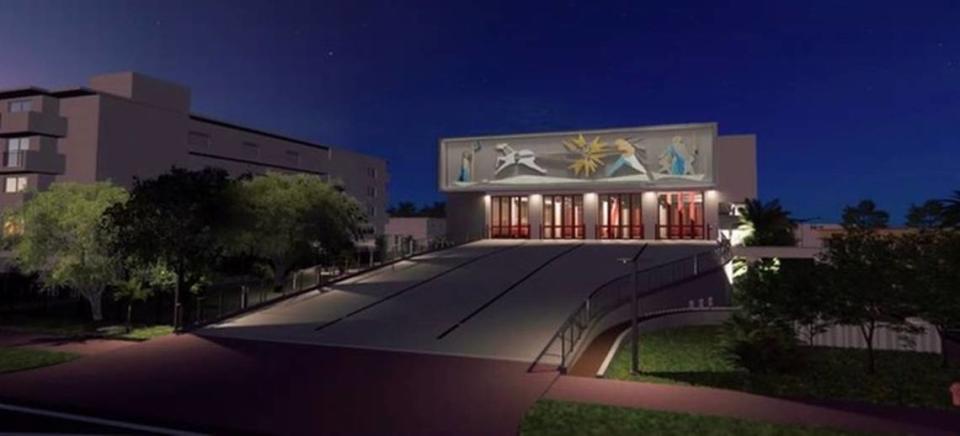
This week, Novick finally hit pay dirt. Apollo soon will fly again.
Miami Beach’s historic preservation board on Tuesday unanimously endorsed the reinstallation of the mural on the facade of a planned new South Beach fire station, the last stamp of approval needed under a city plan that has taken three years of negotiation and review — including several stabs at identifying a suitable location for the artwork.
“I am so excited,” Novick said, as he viewed the dismantled mural at Wynwood’s Bakehouse Art Complex, where it is undergoing a painstaking restoration by a specialized team of art conservators. “It’s a wonderful project.”
The all-but-ensured rescue of the Stewart mural is being touted as a model project at a time when development pressure threatens cherished and historic public art and architecture across Miami.
The costly restoration is being funded in full by Aman Resorts, the luxury hotel chain that has taken over the renovation and redevelopment of the historic 1941 Versailles Hotel, where Stewart had installed his specially commissioned two-part mural — “Apollo Driving His Sun Chariot Across the Sky” and “Latona and Her Twins” — on the front of an annex wing built in 1955.
The main section depicts the Greek god of the sun and light driving a star-like, horse-pulled chariot. At either end are figures representing Apollo and his twin sister, Artemis, as children, and their mother. (Stewart used her later Roman name of Latona instead of the Greek Leto.)
Aman representatives offered to cover the still-to-be-determined cost of rescuing the mural in 2021, when they secured city authorization for a planned gut-rehabilitation of the Art Deco hotel and construction of a standalone luxury condo tower next to it, where the annex that was home to the Apollo mural once stood.
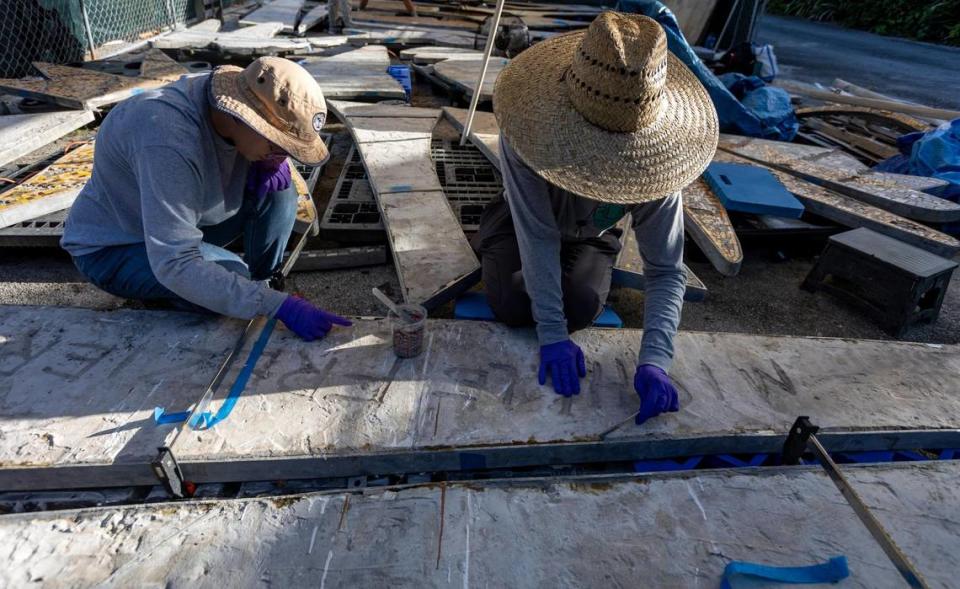
Redevelopment takes down other murals
But the Stewart mural was almost lost to the resort city’s intensive, ongoing wave of redevelopment, which has claimed a handful of buildings that while not historic themselves, bore cherished exterior public artworks or architectural features. Just last year, the Miami Design Preservation League got another developer planning to tear down a building to donate to the city another monumental mosaic mural, this one depicting American flags and figures from U.S. history by artist Enzo Gallo.
Hotel developer CitizenM paid the $170,000 cost of carefully cutting the 50-year-old mural out of the Alton Road building’s facade in sections, which are being stored nearby until a new home for the artwork can be found.
In Miami, meanwhile, a familiar mosaic mural of Cuban independence hero and poet Jose Marti on a demolished building that long overlooked Interstate 95 in downtown Miami is in storage following its removal and also awaits a plan for reinstallation, said Rosa Lowinger, the prominent conservator who is supervising work on Stewart’s Apollo mural.
In an earlier version, the Versailles project was led by developer Alan Faena, who planned to make the hotel part of his larger, abutting Faena District, in partnership with billionaire investor Len Blavatnik. Faena got city authorization to tear down the Versailles annex, which was not judged to be historically or architecturally significant.
But Faena and the city somehow both overlooked the mural — until Novick, who had been intrigued by the artwork since childhood, piped up publicly, providing research that showed the mural was a valuable work and that Stewart was a significant artist. As an art historian, Stewart also played a leading role in the recognition and acceptance of graffiti as art.
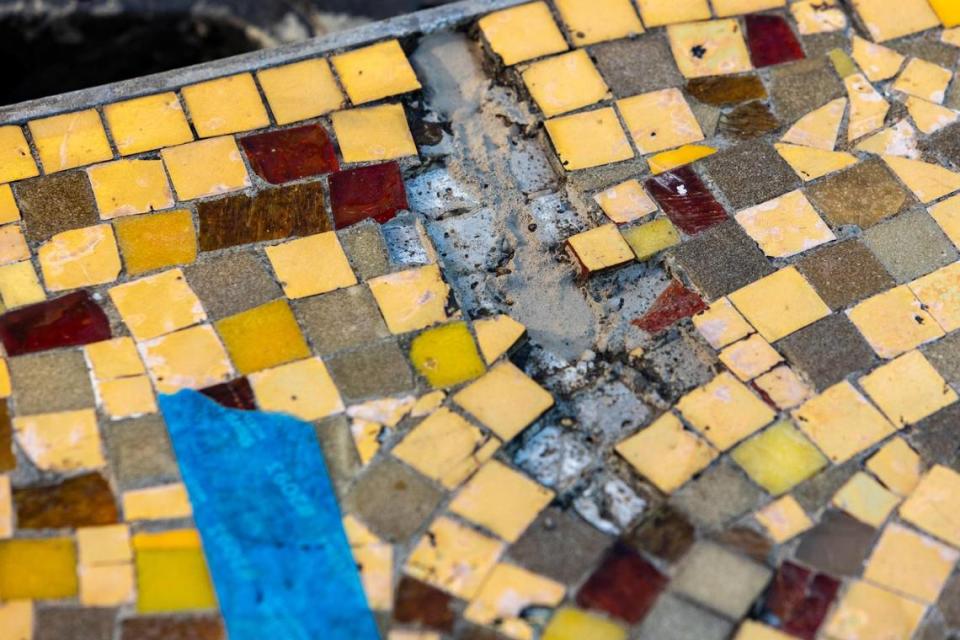
Novick, who operates the Sherbrooke Hotel and is former chairman of the historic preservation boards at both Miami Beach and Miami-Dade County, rallied support from preservationists on the Beach. Faena then had the mural taken off the wall and sent to Little River, but he was unable to follow through on his redevelopment plan. Blavatnik is now backing Aman founder and fellow billionaire Vladislav Doronin on the project.
Because the city had already authorized Faena to demolish the Versailles annex, though, officials said they were legally powerless to require preservation of the mural. Novick persisted, however, reminding public officials of the mural’s value at every opportunity. Once Aman attorney Neisen Kasdin offered to donate the mural to the city, with all associated costs to be borne by the developer, the city was able to take formal ownership of the artwork, Miami Beach preservation chief Deborah Tackett said.
“Mitch was really the impetus and the champion for this,” Tackett said. “He really stuck with it, and has been extremely successful.”
‘The perfect fit’
The question then was, where could the massive mural go?
“Where do you find space for a monumental piece like this?” noted Daniel Ciraldo, executive director of the Miami Design Preservation League, a Beach organization that supported Novick’s quest.
The city considered several options, and drew up renderings showing the mural installed at, among other prominent spots, the Miami Beach Convention Center and the nearby Seventeenth Street Garage, but for various reasons rejected those.
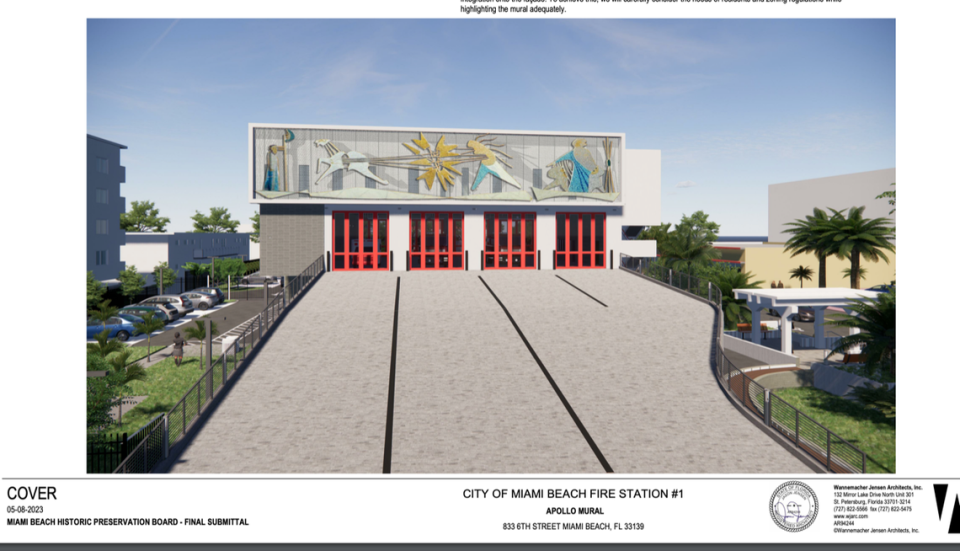
Officials finally settled on the new Fire Station 1, which by chance will be wide enough to accept the mural on its west facade, on the second story over the firetruck entrance ramp. And because it isn’t yet built, its designers at the St. Petersburg firm of Wannemacher Jensen Architects could tweak their plan to add structural columns needed to support and properly display the heavy mural pieces.
“We looked at many different city facilities, and this is actually the perfect fit,” Tackett told the Beach preservation board on Tuesday.
In a twist, the location on Sixth Street and Jefferson Avenue in a city historic district has not been without controversy. Construction of the new $18 million firehouse will require demolition of the South Shore Community Center, a building by legendary architect Morris Lapidus, designer of the Fontainebleau Hotel.
But preservationists and city officials say the firehouse will give new life and prominence to the mural in the Flamingo Park Historic District, and the work fits thematically because of the racing chariot and the flaming sun.
“The firefighters love it, because it does speak to what they do,” Tackett said in an interview.
Under the approved installation plan, the mural will be backed by a metallic screen to separate it visually from the building and camouflage the metal supports that will anchor the artwork. The plan also calls a subtle, glowing illumination at night. Like the fire station building, the mural installation is designed to resist Category 5 hurricanes.
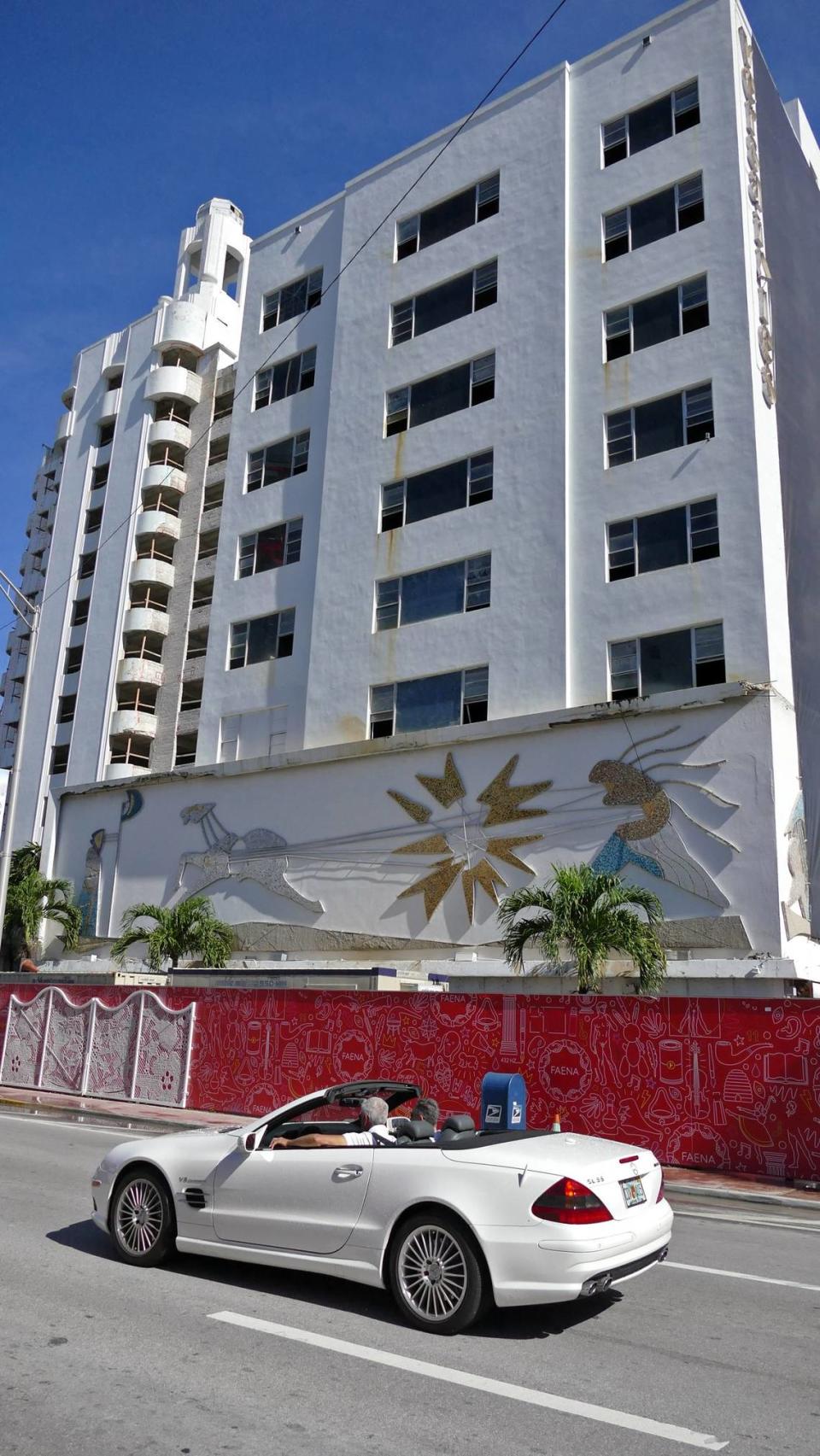
Aman’s commitment on the mural doesn’t cite a dollar figure, Tackett said. But everyone involved says the developer has been unstinting in meeting expenses. An Aman spokesman said the company does not yet want to disclose how much it has spent. Novick said he understands Aman has so far spent several hundred thousand dollars, and fully expects to pay more by the time the reinstallation is done.
“The restoration of the iconic Versailles Hotel is a centerpiece of the plan for Aman Miami Beach, and the development team has long been committed to preserving and restoring Jack Stewart’s historic mural, which previously fronted Collins Avenue,” Aman development director Mark Witte said in an emailed statement to the Miami Herald. “We applaud the Historic Preservation Board’s decision to locate the mural on the façade of the City’s new fire station, where it will once again be on public view for all to enjoy.
“The mural’s restoration is nearing completion at the Bakehouse Art Complex, and we will soon be working with the City to facilitate its installation.”
That’s still a ways off. Construction on the fire station is scheduled to start in spring of 2024, with completion expected in summer 2025, according to city officials.
Apollo artwork getting overhaul
In the meantime, there is considerable repair work still to be done on the mural, said Lowinger, CEO of RLA Conservation, a company based in Miami and Los Angeles that specializes in restoring large outdoor art and architectural works.
Lowinger said the mural’s hasty removal added new damage to the deterioration from decades of exposure, but added: “It’s totally fixable.”
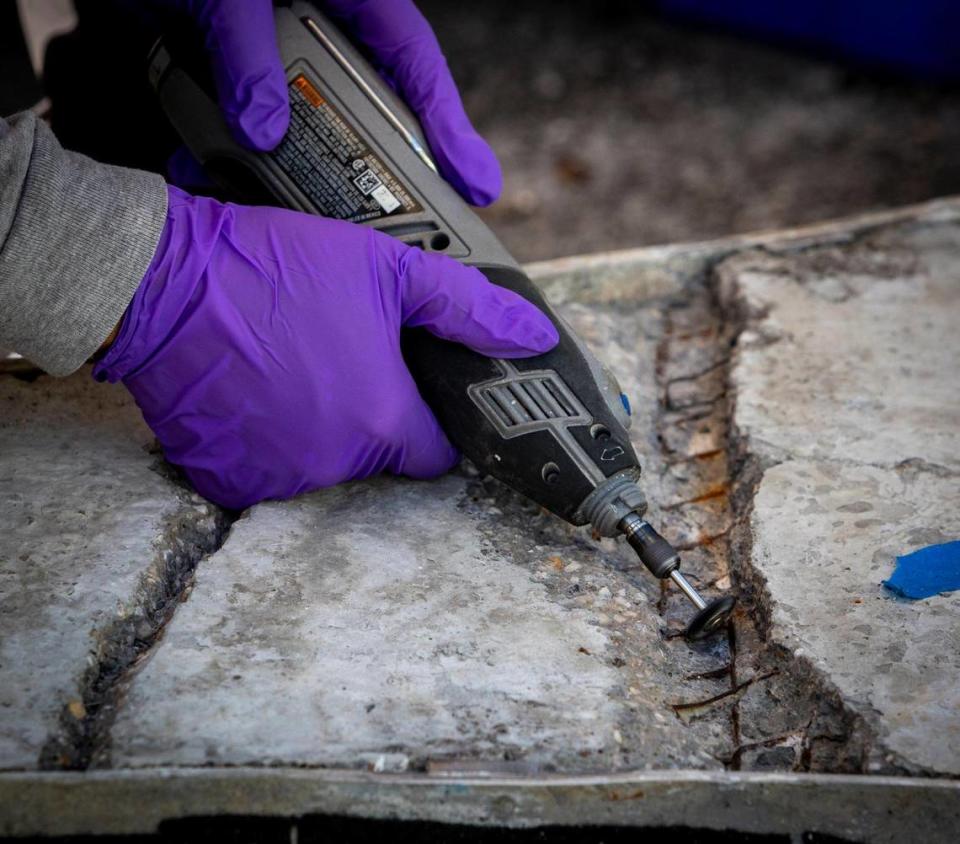
She called the mural an “exuberant” work well worth the cost and effort of restoration. That has meant chipping carefully away by hand at the concrete backing to expose and replace corroded steel rebar that was expanding and damaging the mural surfaces, replacing and rewelding aluminum framing, and judiciously applying anti-corrosion coatings to make the mural better able to repel water in the future.
The firm also hired an engineer to evaluate the repairs and ensure the mural would be structurally strong enough when restored for reinstallation, Lowinger said.
Next comes replacing missing glass tiles, which required finding identically matching samples, RLA assistant conservator Elena Bowen said.
Aman and conservators are now working on securing a bid from contractors for the mural’s installation at the firehouse, Lowinger said. The conservator, a Cuban-American who has also worked on the long-delayed project to renovate the shuttered Miami Marine Stadium, said the public support for saving the Stewart mural has been especially gratifying.
The style of Modernist outdoor mosaic mural the artist adopted was often featured in Mid-Century architecture in Cuba, the rest of Latin America and Miami, Lowinger noted.
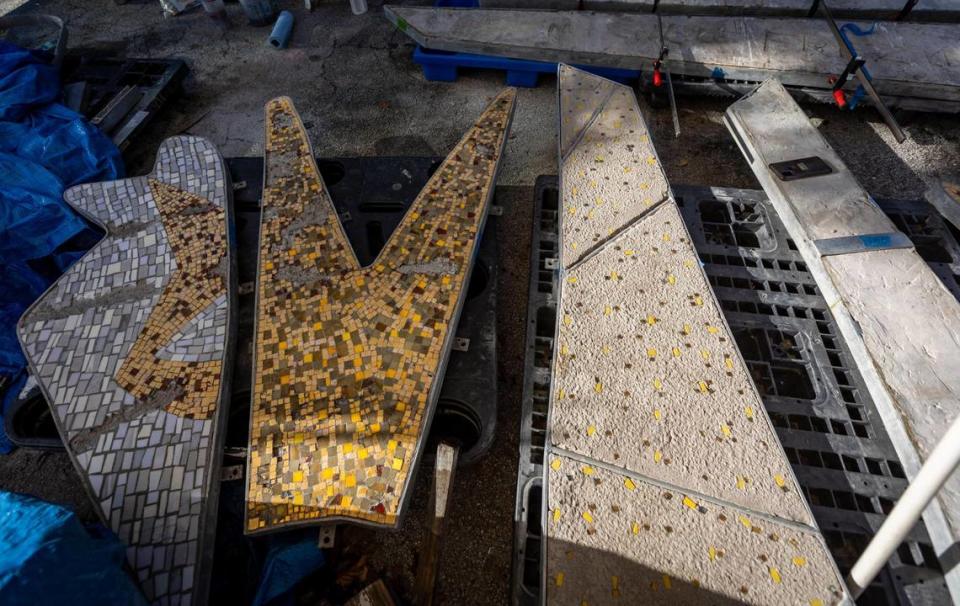
“Aman has been great. The city’s been great. The thing too for us, which is particularly meaningful for me, is Miami and Miami Beach, in particular, has been very welcoming of the work that we do, and to find that level of appreciation is wonderful.
“People rallied and understood its importance and value,” Lowinger said of Stewart’s Apollo mural. “This is going to be a really happy story for everybody.”

